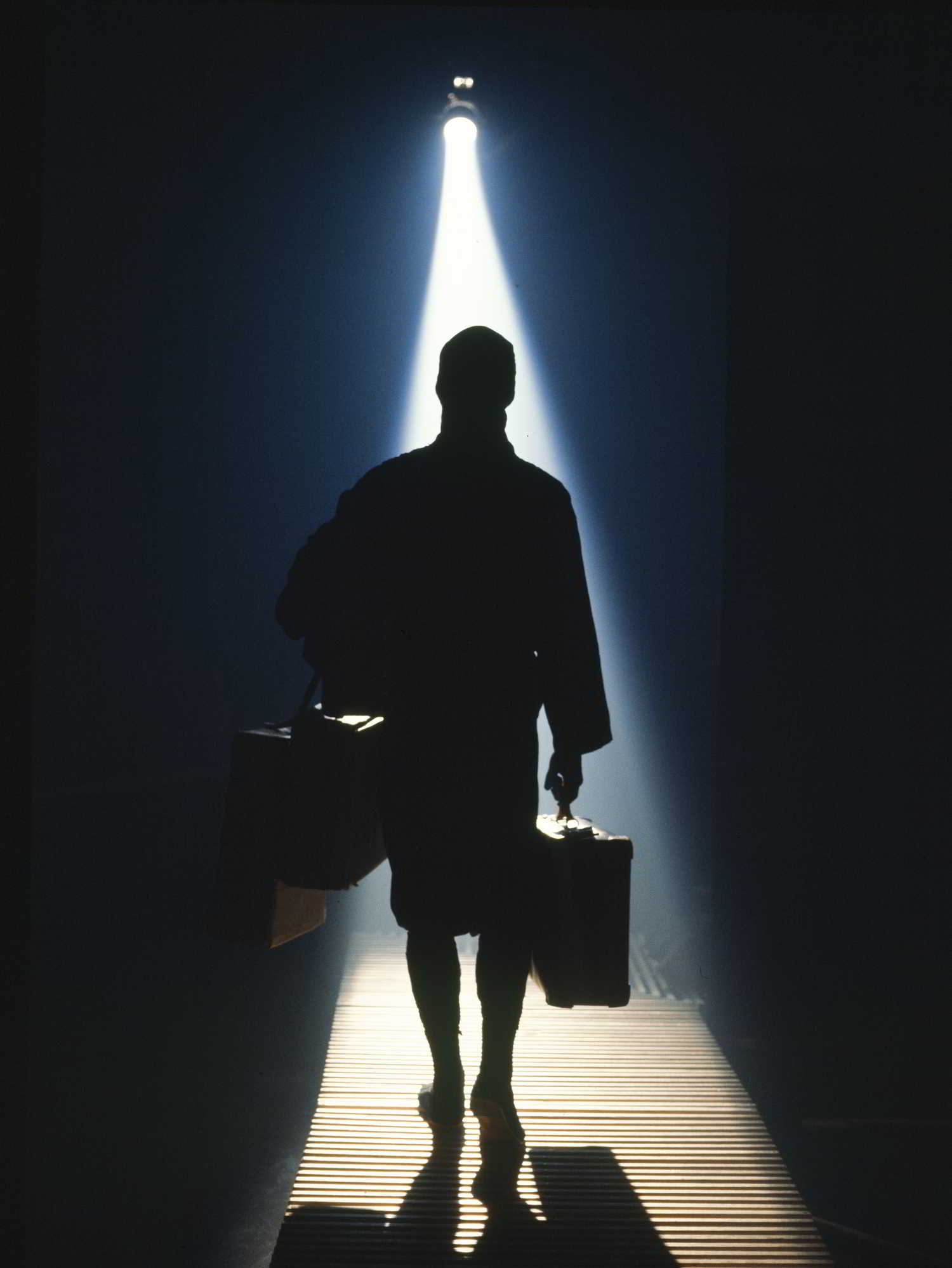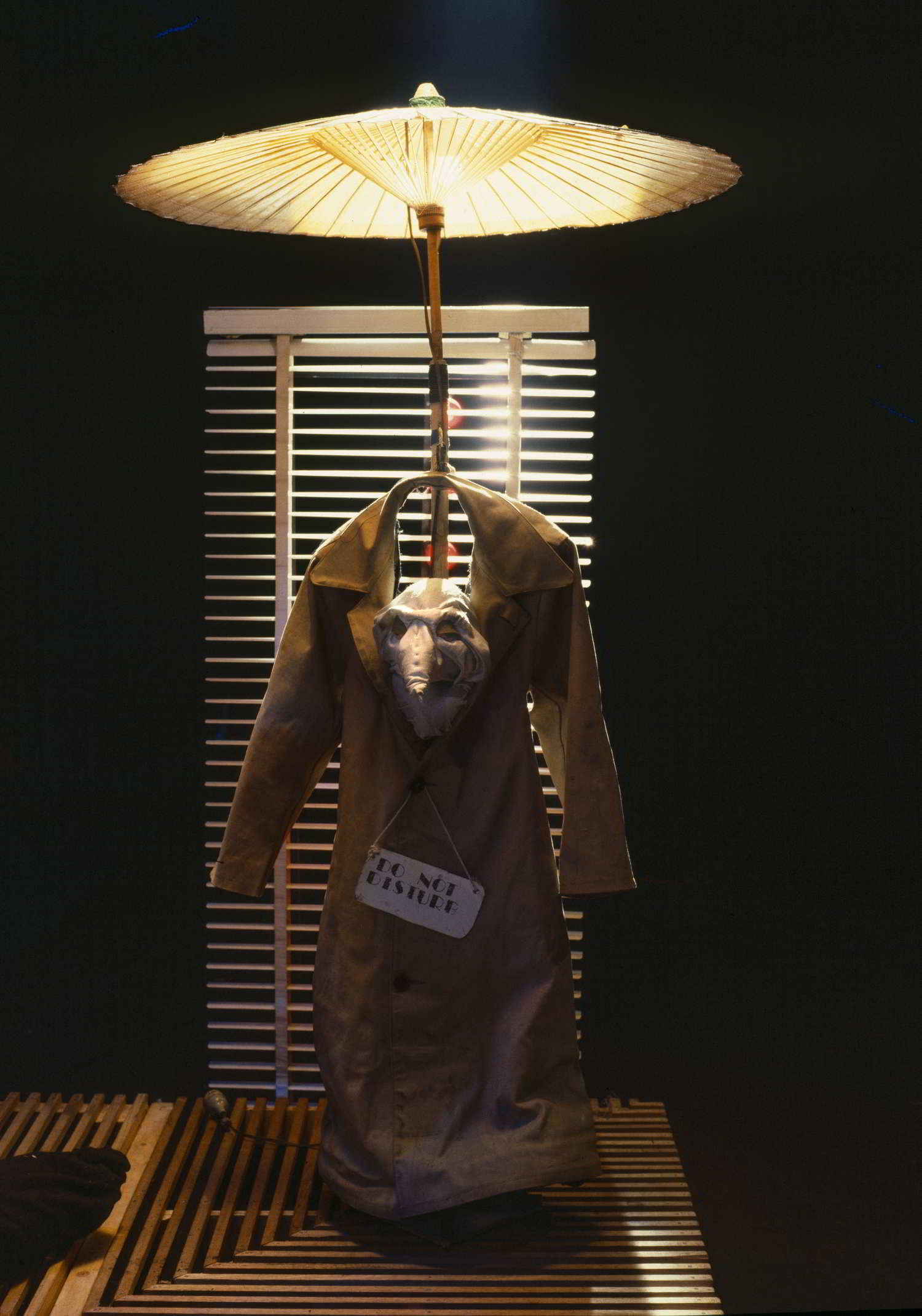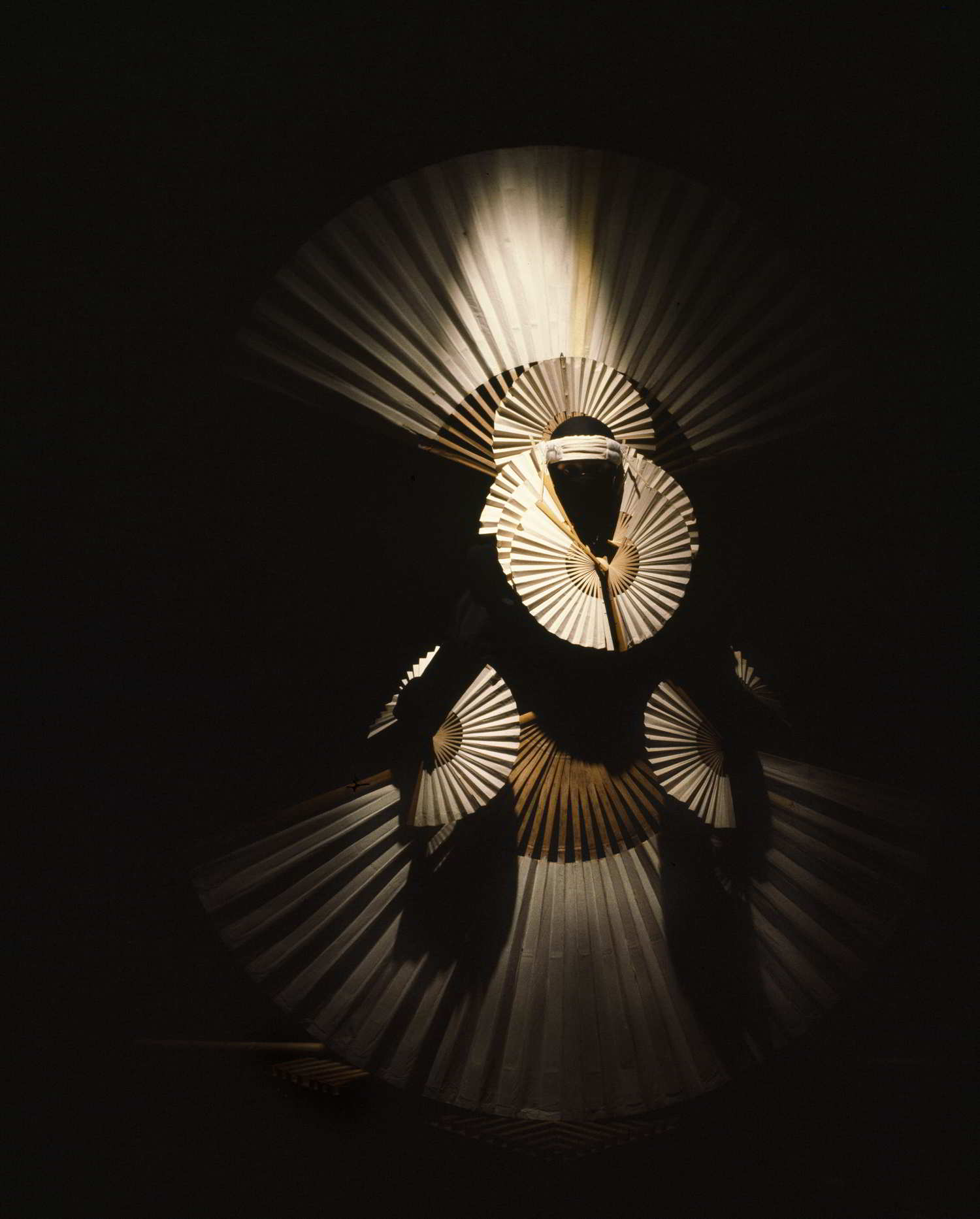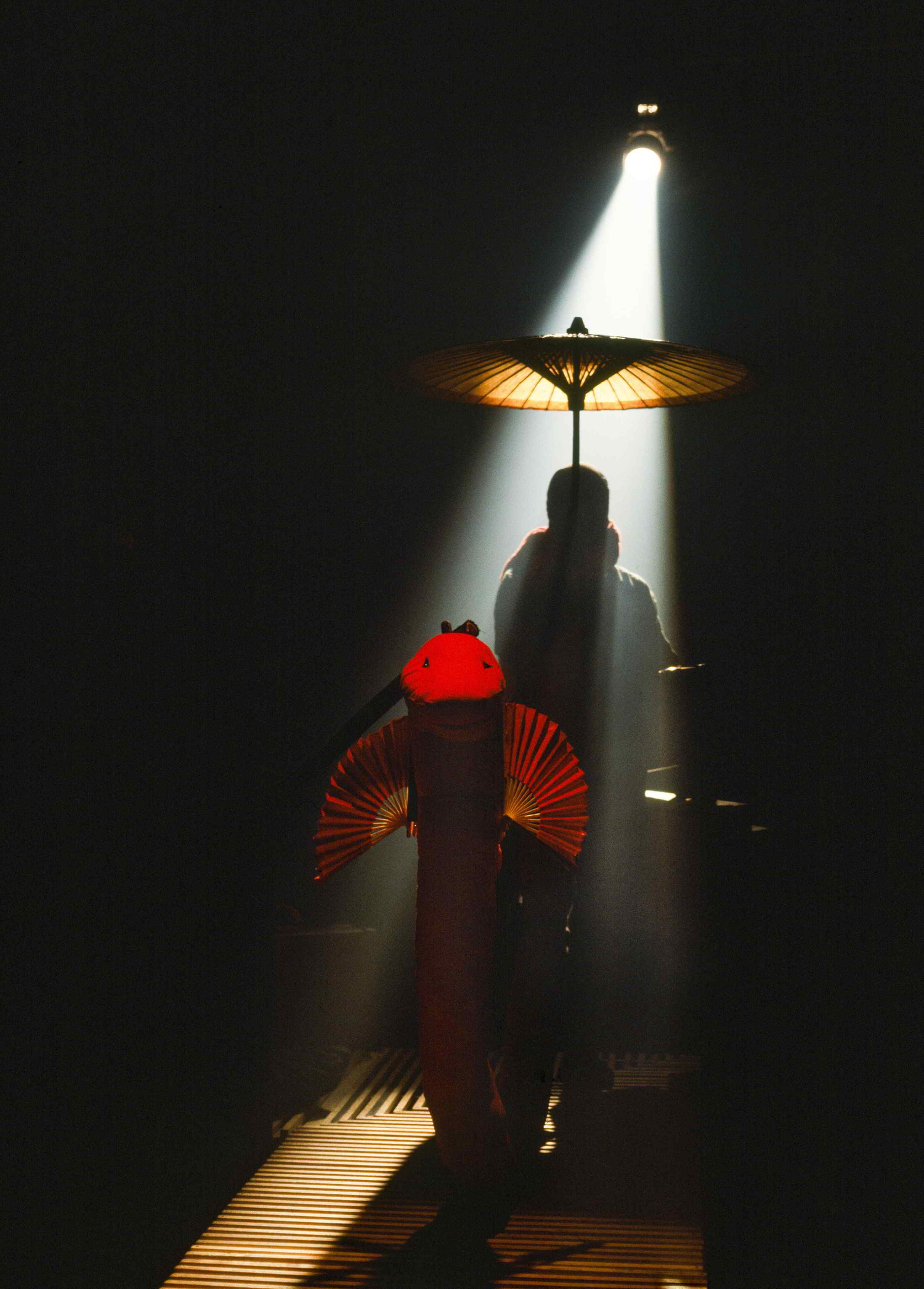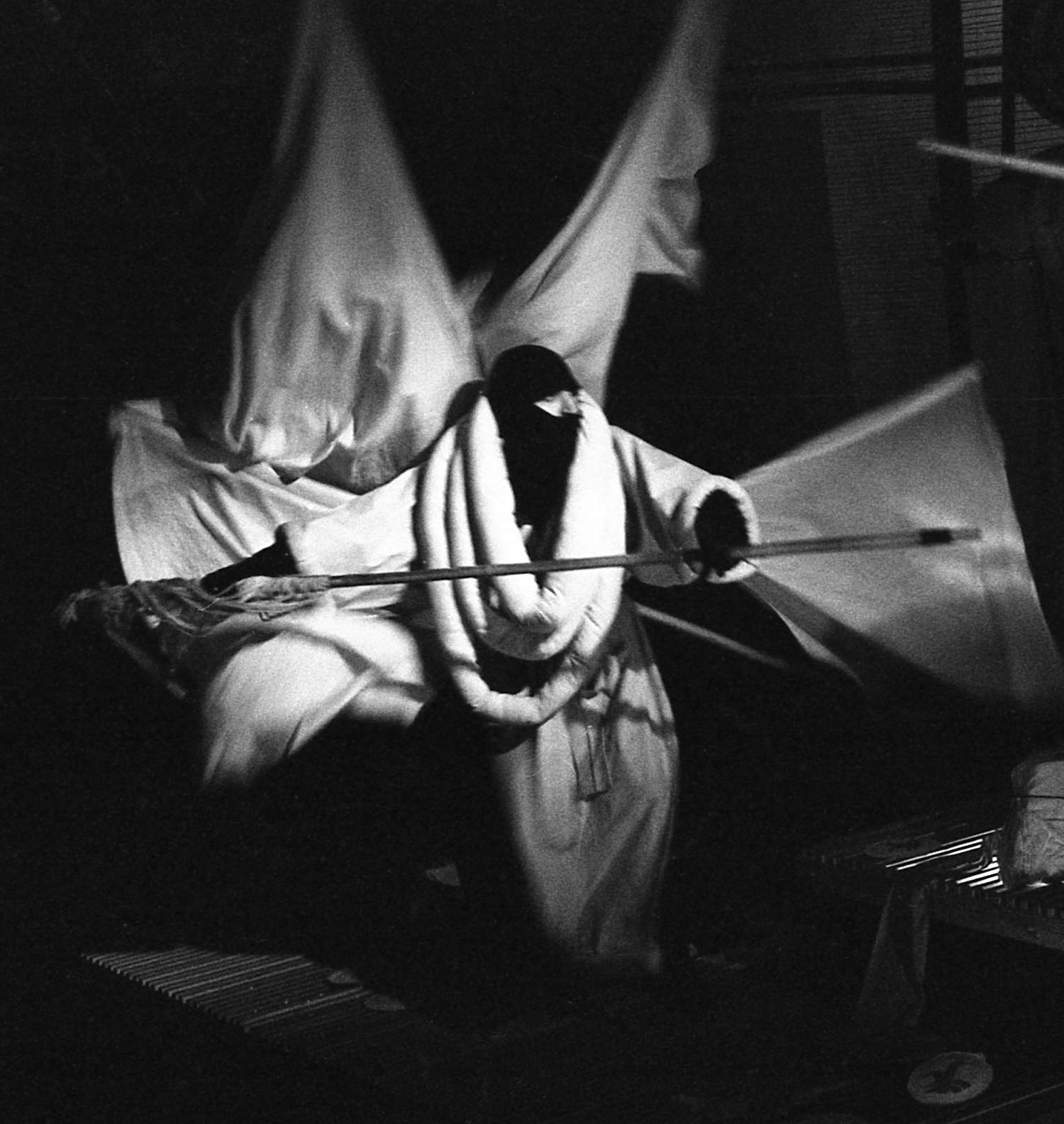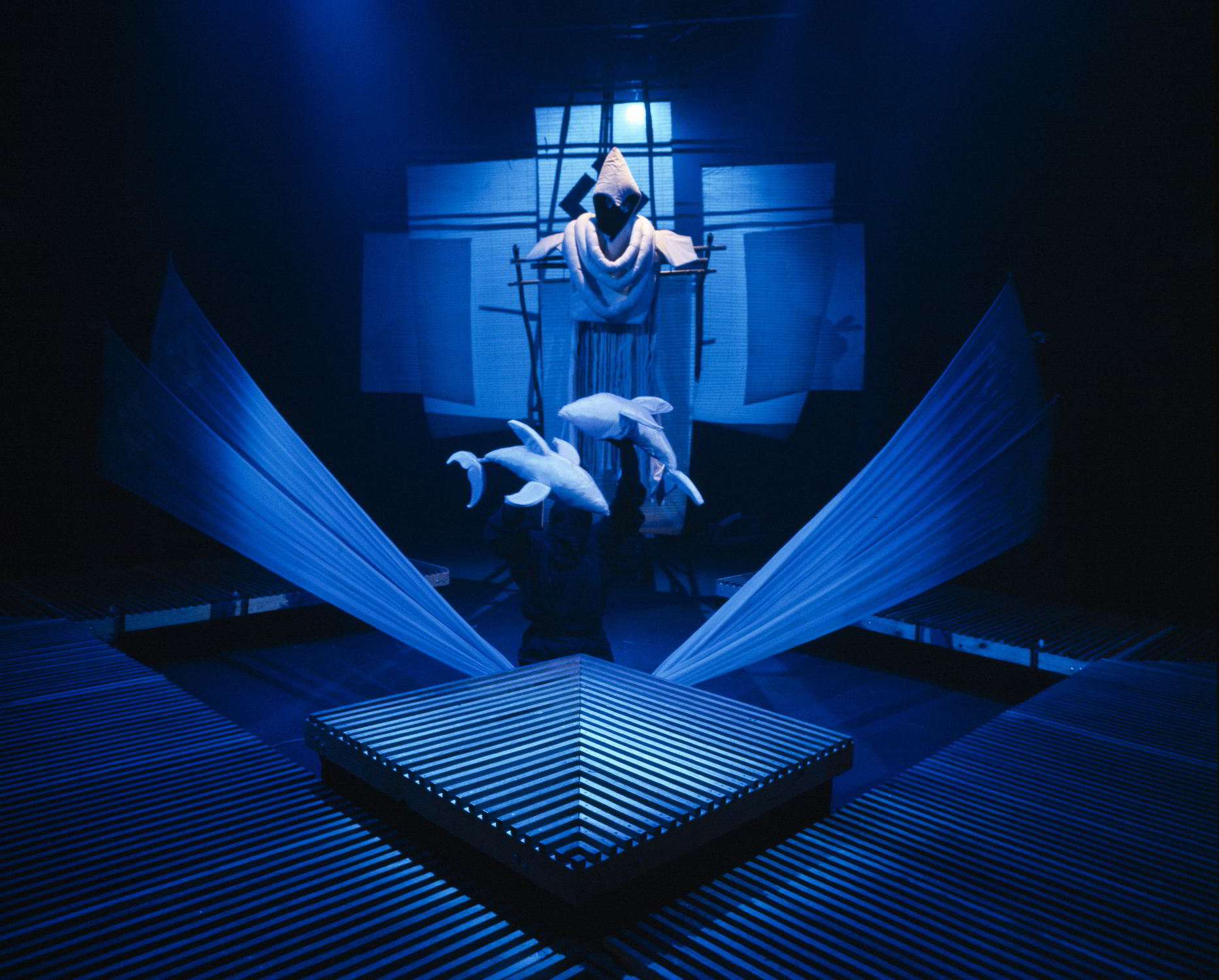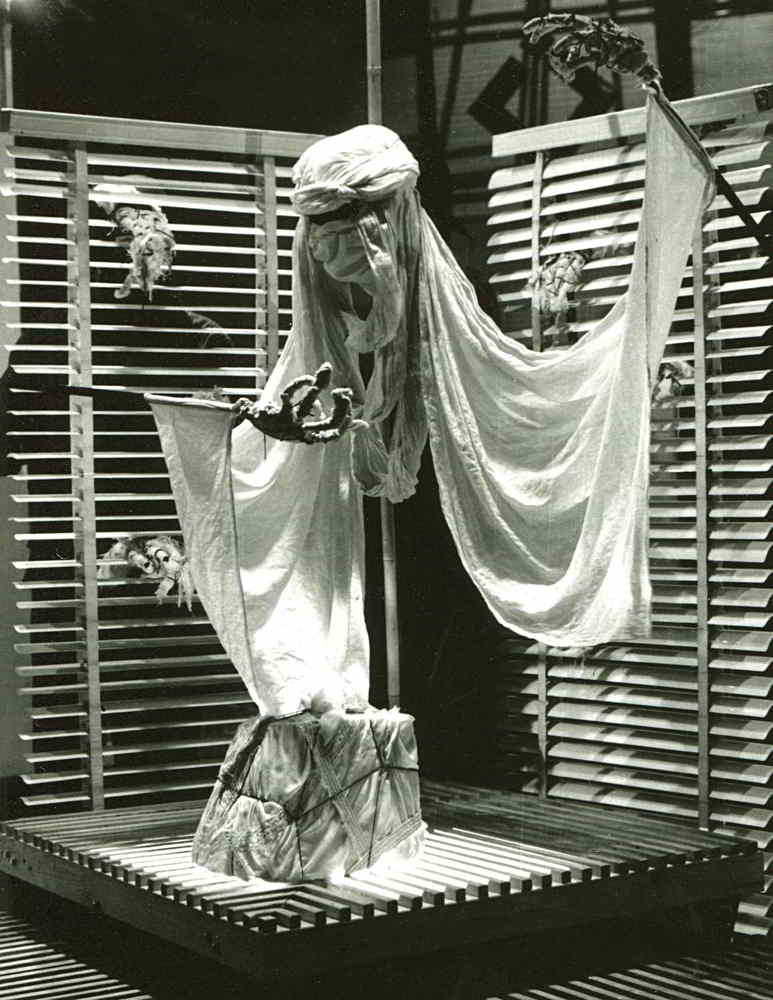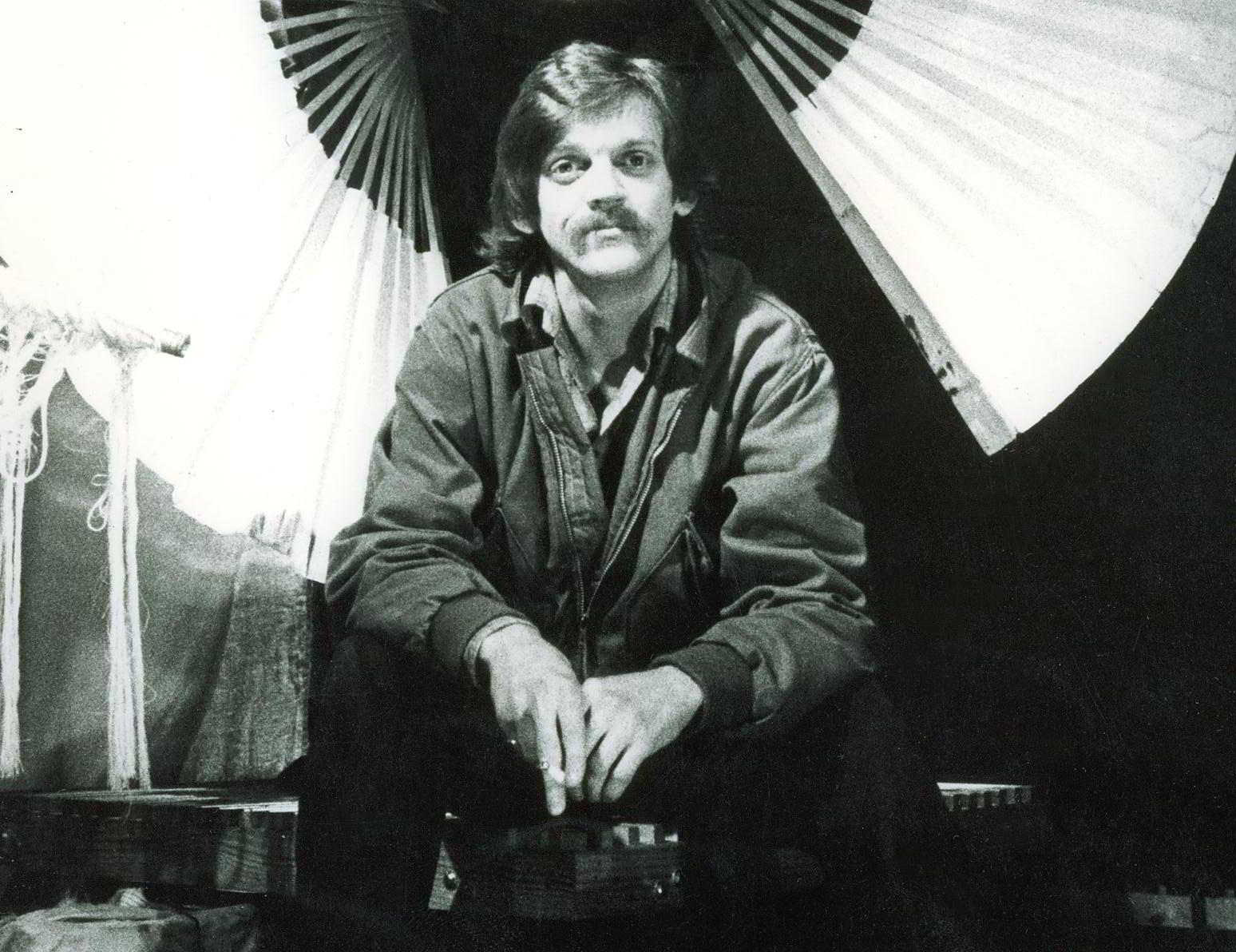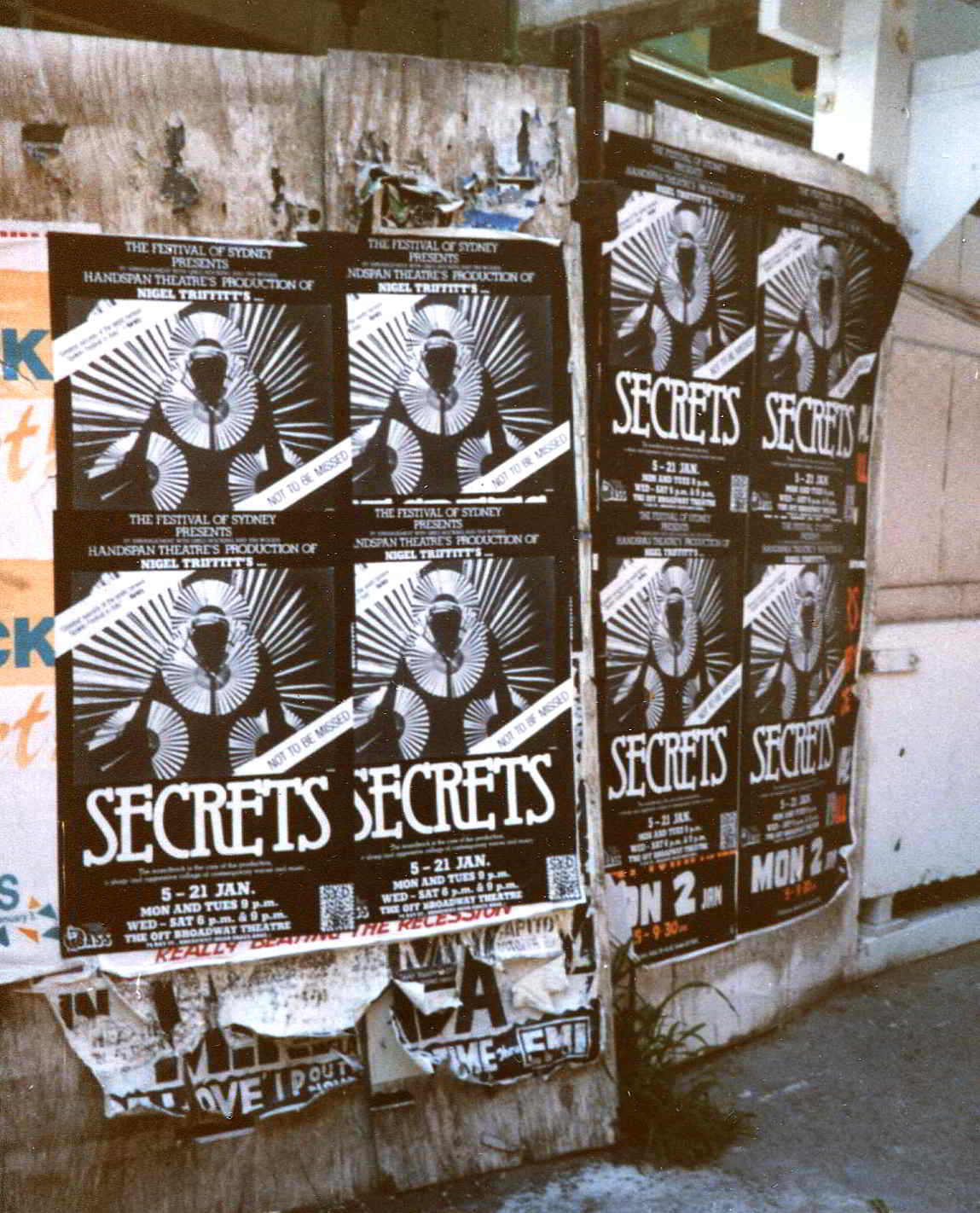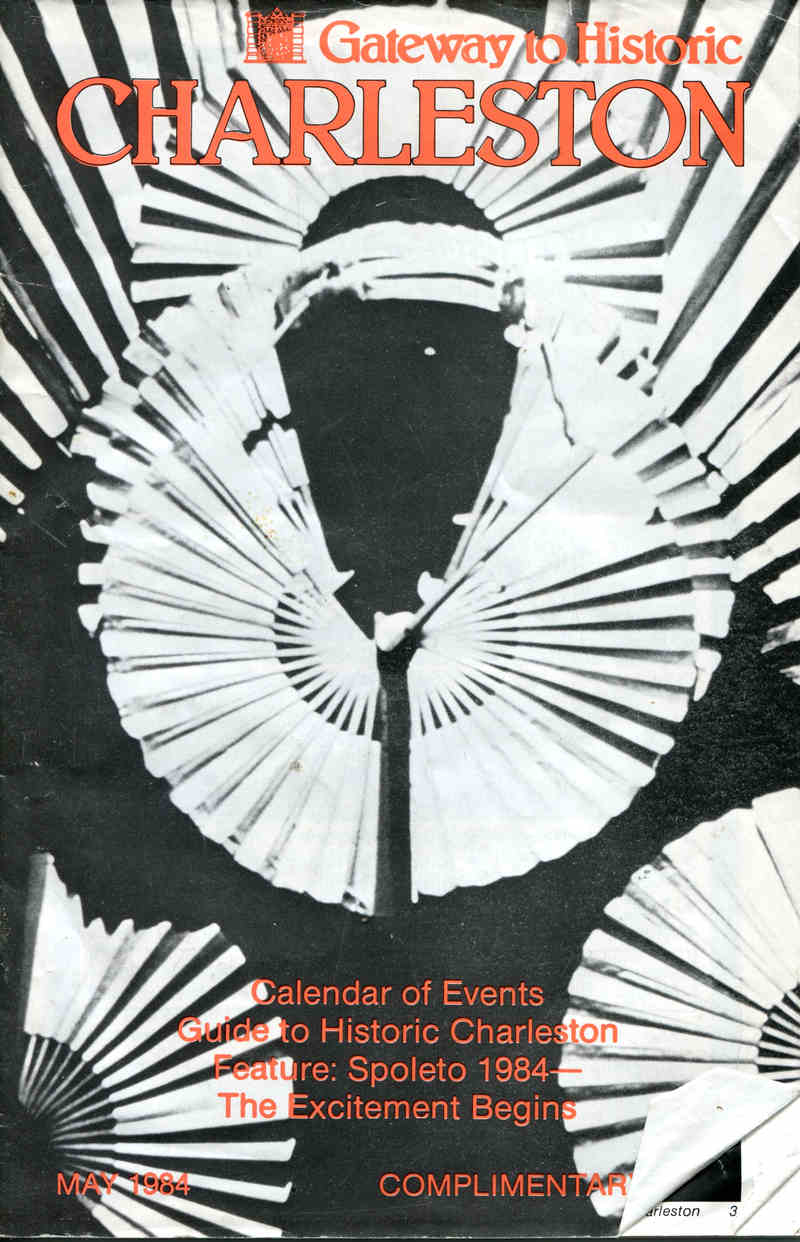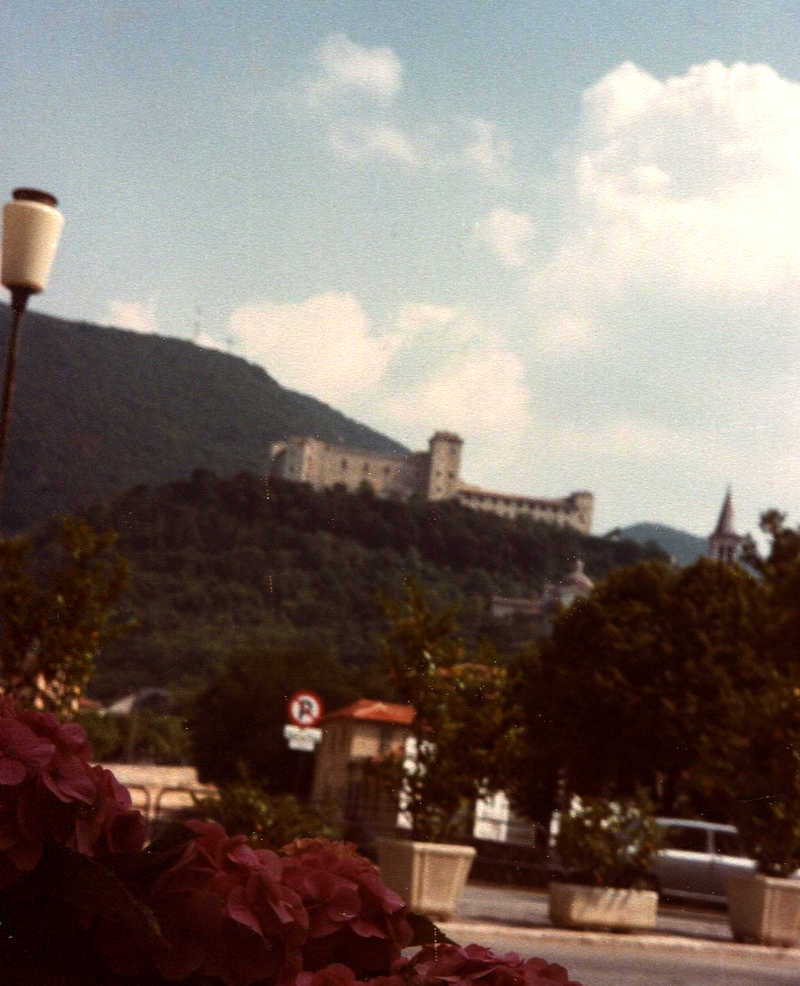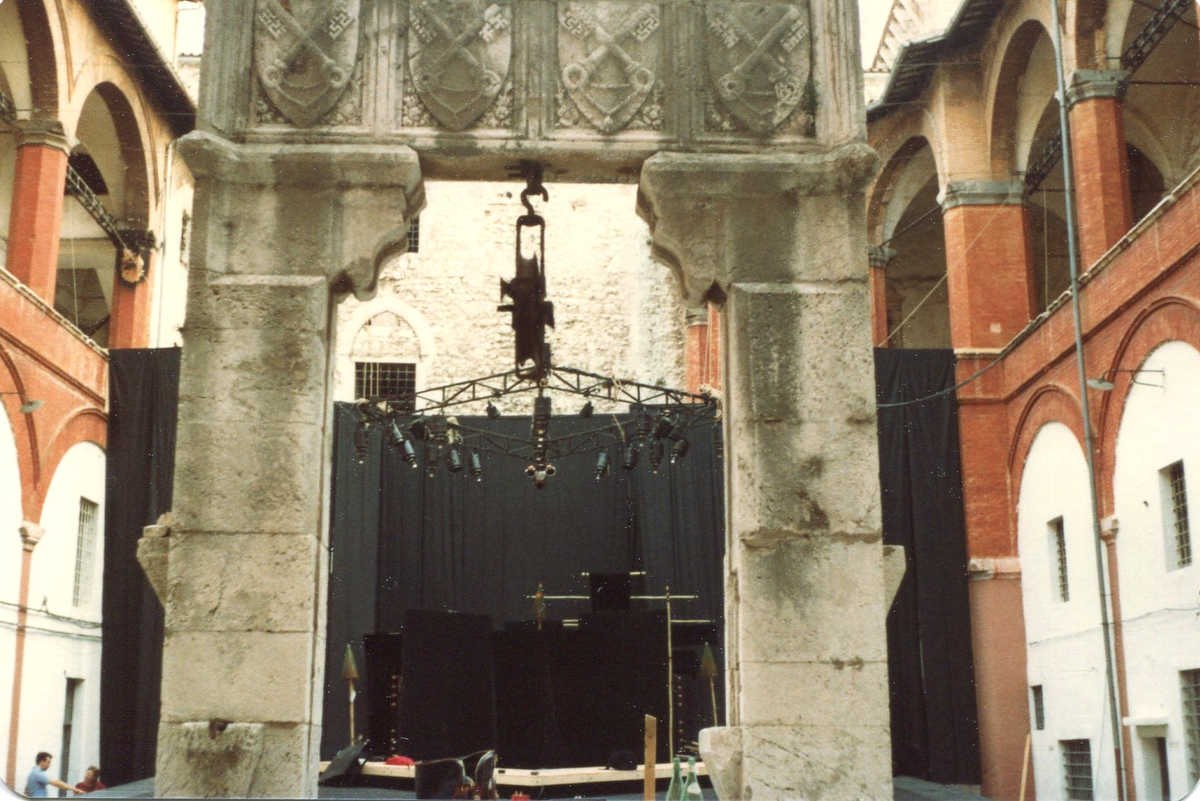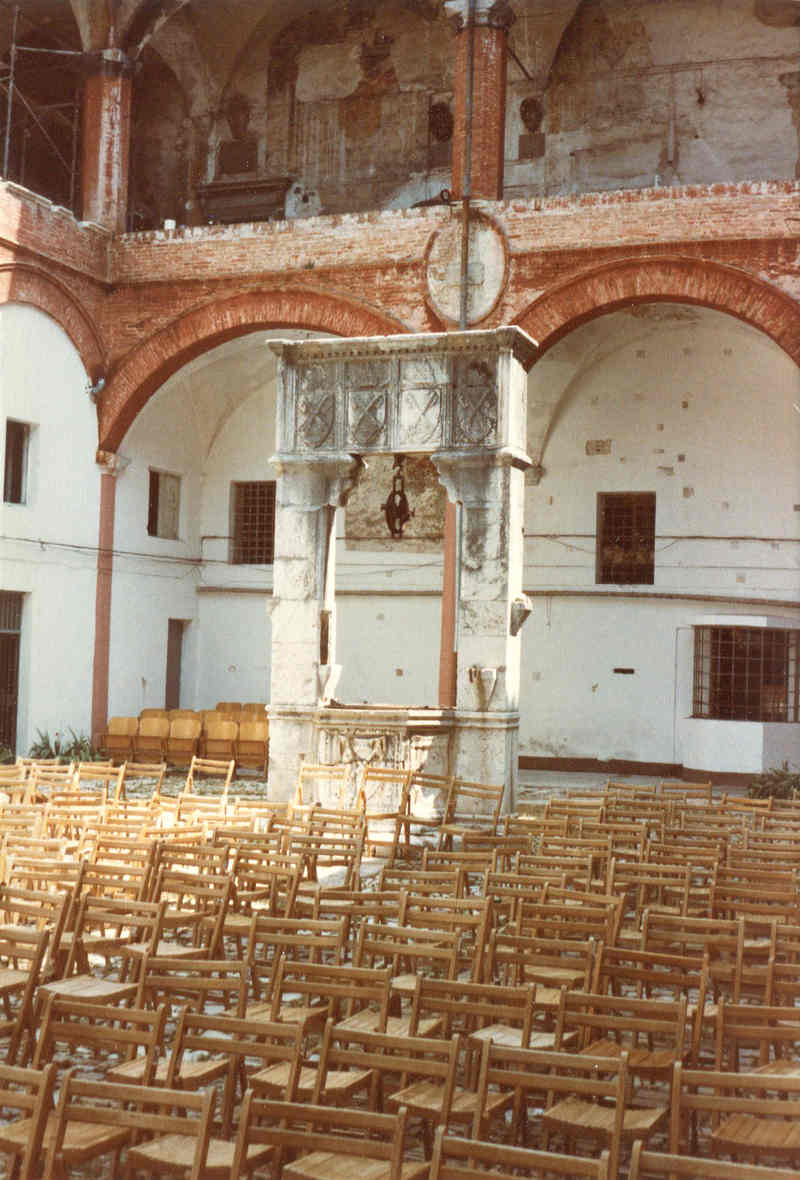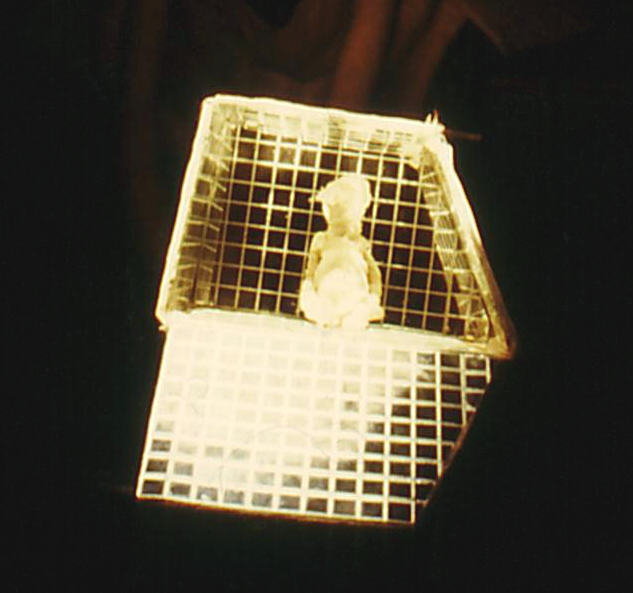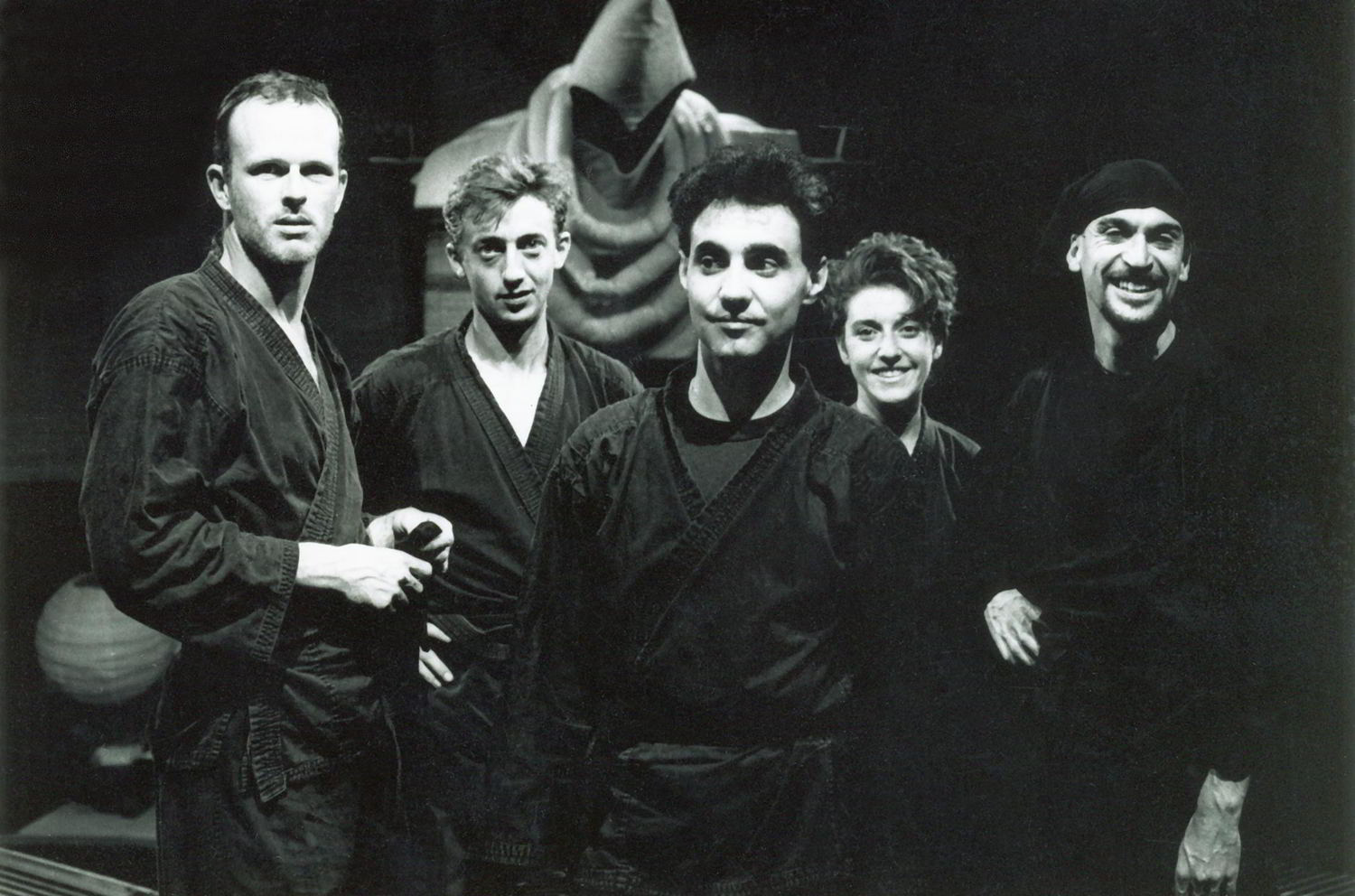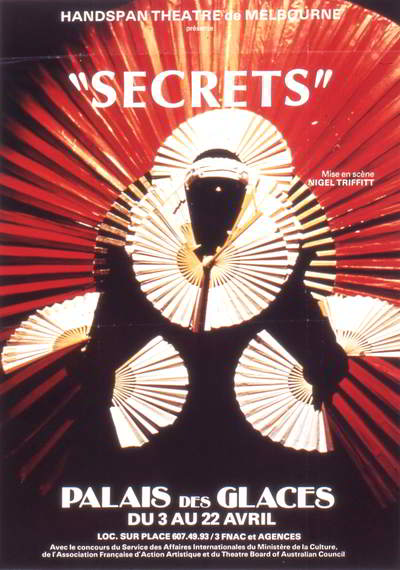| Premiere | 21 January 1983 |
| Venue | The Space Adelaide Festival Centre, Australian International Puppet Festival |
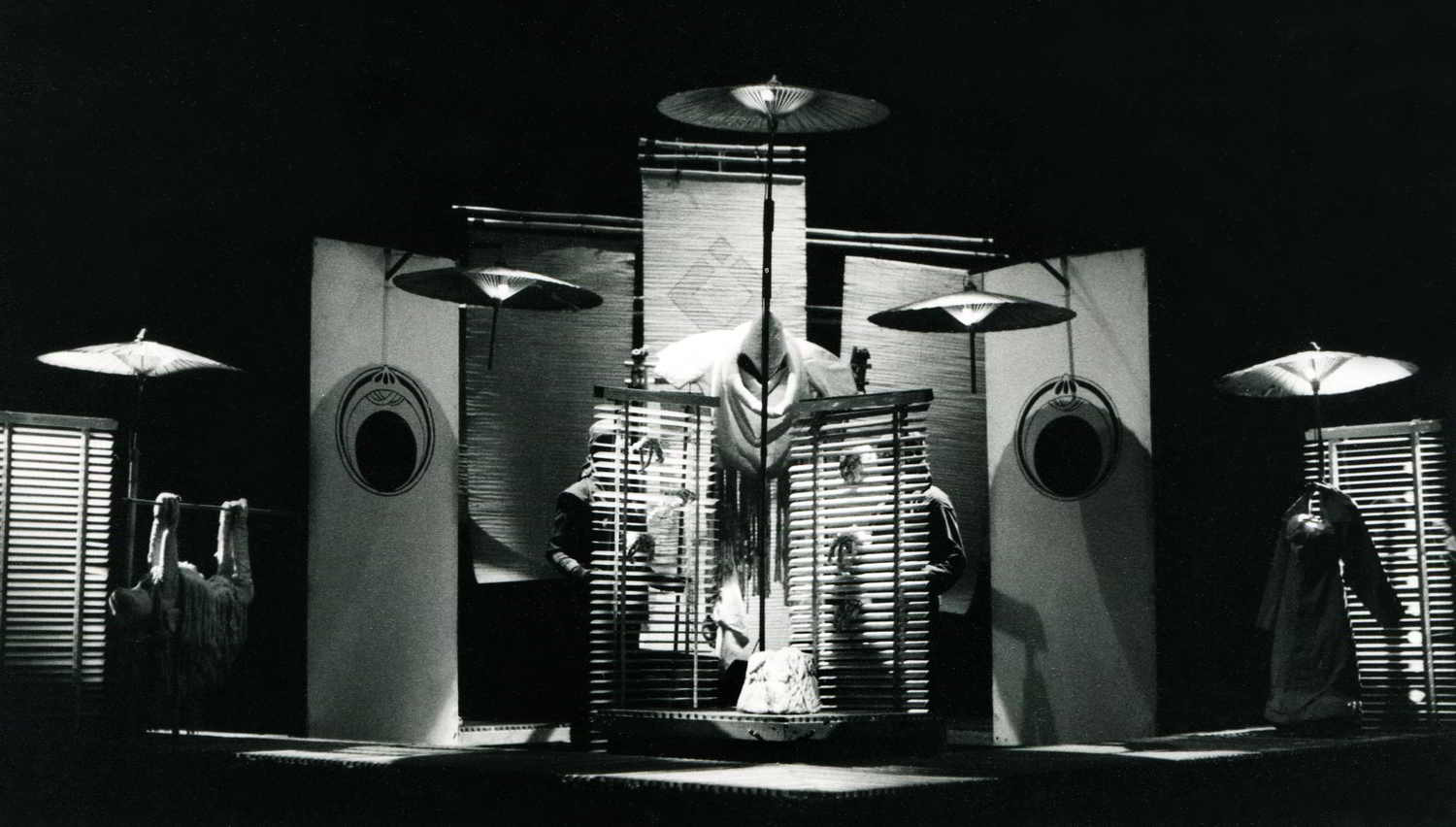
‘’Spoleto ‘84’’ Journal unknown,1984
SECRETS’ stellar career began with a Best Production award in its premiere season at the 1983 Australian International Puppet Festival in Adelaide, and from then toured in Australia, Europe and North America until 1986. It both spearheaded Melbourne’s connection with Italy’s Spoleto Festival and helped pave the way for small Australian companies to tour internationally – a rarity at the time.
Devised, designed and directed by Nigel Triffitt in collaboration with the Handspan ensemble in 1982, enigmatic, innovative, and provocative, SECRETS was a landmark production in the company's development. It was its first Mainstage production and from the outset, an extraordinary work, that brought both Handspan Theatre and Triffitt Australia-wide and international recognition.
SECRETS was developed by its original cast and crew: Andrew Hansen, John Rogers, Peter J.Wilson, and Carmelina Di Guglielmo. Ian Cuming. After the opening season, Lizz Talbot replaced Carmelina di Guglielmo in the role of the Fan Lady and Winston Appleyard replaced Ian Cuming as the Black Samurai. For its 264 performances in the following five years, the touring cast remained relatively intact their creative investment assuring a compelling ensemble presentation, performed with unnerving exactitude1
Handspan handle Triffitt’s dream with tender love and theatrical expertise.
Each effect is so complex its pleasure doubles back like an undertow when you finally figure out how it is achieved
Lauded and lambasted, SECRETS polarised audiences, provoking responses ranging from 'a visual symphony' to 'industrial strength twaddle'. To anyone who sought a definitive explanation of SECRETS' polymorphic parade of imagery, Triffitt's reply was "If you want a story, go read a book."
Staged with puppets and moveable objects in a kaleidoscopic design of universal and multicultural symbols, SECRETS was performed to a soundtrack that mixed popular music and contemporary voice-over snippets in a pulsating and dramatic continuum. Its themes of anger, alienation and despair referenced the global and universal issues of assassination, terrorism and survival, as topical in the early 1980s as they are relevant in the 21st century.
It was an ambitious dream for all concerned, one that created a unique theatrical production.
The Play
SECRETS was a series of choreographed tableaux: operators in black ninja costumes enclosed the exquisite Fan Lady in a Star of David; an empty trenchcoat revealed disembodied secret-selves; oriental warriors jousted in a stylised battle; a traveller followed a phallic serpent; a sloth licked a high-heel shoe hanging in the stern of a revolving ship; and psychedelic circles spun on a ferris wheel. Through it all a parcel, delivered in a pram, travelled by sea to the ending where the box opened to reveal a tiny, fragile wire figure floating in the beams of its mirrored lining.
Triffitt's approach is that of an imagist who paints in light and sound, drawing on his subconscious for inspiration
SECRETS’ soundtrack, effectively the 'script' for the show, mixed fragments of voiceover from documentaries, newsreels and broadcasts with excerpts from contemporary music. These were recording on cassette tapes by Nigel in hotels rooms around the world.For the premiere Puppet Festival season these were mastered to reel-to-reel tape by the production department at the Adelaide Festival Centre - two closely guarded copies only, always retaining a faint but discernible background hiss.
It intersperses music and noise with the voices of assassination victims like Martin Luther King and John Lennon; the audio on Lee Harvey Oswald’s shooting by Jack Ruby and various radio announcers’ report of the Kennedy shootings.
For its public premiere Philip Lethlean developed the Lighting Design and plot with Triffitt guided by Lorraine Wheeler from the Festival Centre. Manually operated by Philip for every performance, the downlights, side light-curtains and congo blue insensified the show's impact.
Things are never what they first appear to be. Puppets appear in midair, heads float across the stage; a baby carriage rolls on stage apparently pushed by a puppet figure, but the figure proves to have only head and arms and is really being pulled by the carriage. Each scene subtly shifts through a slow movement, where the images build and mutate with a fascinating, unexpected rhythm, to a sharp snap of light and all is gone – immediately replaced or transmuted to start another episode.
Charleston, S.C., USA, 31st May, 1984
Nigel Triffitt tried to look on humanity as a cultural totality: That is why he mixed symbols of different cultures and suggested their common existence. That is why among Japanese screens we saw characters which might as well have belonged to the Christian or to the Muslim world. For the same reason the warriors threatening the world were like some characters of Peking Opera though they were not nationally marked.
London International Puppet Festival, Animations June/September, 1984
Secrets great strength is its non-verbal attack on the creeping complacency of mainstream theatre … Punch and Judy fans will probably be the first to acknowledge that Nigel Triffitt’s Secrets has hurled the art of puppetry irretrievably into the twilight zone
The Journey
The concept for what was to become SECRETS evolved from discussions between Helen Rickards, Ken Evans and Nigel Triffitt in a series of meetings in Edinburgh in 1980.
Triffitt's previous work with the Tasmanian Puppet Theatre Momma's Little Horror Show (1978) had sparked his interest in trying to find a visual language in his work. Rickards and Evans were keen to create develop the form of Momma's ... to create an equally entertaining, but conceptually more substantial, new production. Influenced by their travels outside Australia, the work was conceived to represent a perspective on contemporary world tumult through visual metaphor and symbols. It was to be produced for touring to Australian audiences (initially envisaged to fit in a Kombi van!), and potentially overseas as well.
With a small project grant, 2 Handspan was able to commission the work to be developed with the company ensemble in 1982. Triffitt brought his draft soundscape and conceptual drawings to the Handspan studio where he harnessed the performance and technical strengths of the ensemble in a focused collective development process. Under the working titles, Rough Cut and Yassassin, SECRETS evolved over two intensive workshop/rehearsal periods between which Triffitt finalised the soundtrack and built his models based on the staging and imagery that had been created in the rehearsal room.
Coinciding with the first preview of the production's development, Nigel was told of his adoption at birth, previously a family secret. It was this momentous personal revelation that not only gave the play its title, but deepened the drama and poignancy of the work as it progressed to its final version. Never explicit, its undercurrent connected the universal imagery with raw personal emotion that contributed significantly to the production’s subsequent palpable artistic impact.
Triffitt explained that when one finds out one is adopted, one goes through a number of emotional states. Anger is one of them. "And I translated that anger into a kind of brief examination of terrorism and violence."
The work evolved as it was created, Nigel adding found images and objects from around the studio and beyond3
. as much as drawing designs to be articulated by the puppet makers there.
I can’t sum it up other than to say it’s connected with terrorism. It’s connected with getting that angry and that frustrated that you could pick up a gun and start shooting. Now this is not an adult way of going about solving problems, so I suppose the show is about – it’s legit to go through that range of emotions, but obviously you have to come out at the other side, and that’s the rebirth thing at the end of it. I wanted to reflect a state of mind…I wanted to say well here are these emotional conditions … can I find a visual language which will somehow translate to other people what it’s like to have these feelings. If I could sum it up in words, I would have written a pamphlet or a book on it. I’m not able to sum it up in words, I can only sum it up in pictures.
SECRETS was booked by Andrew Bleby for the Australian International Puppet Festival immediately after the Showcase in June 1982. With a gig lined up and time, if little money, both Triffitt and Handspan were excited by and committed to, its continuing evolution and refinement.
SECRETS development extended throughout 1982, a rewarding process that tightened the work's focus and dramatic balance and allowed for the extensive rehearsal its techniques required. The play showcased again in December 1982 and secured a Melbourne season at the Universal Theatre for the following year.
When the play premiered at the Australian International Puppet Festival in January, 1983 it was to success and acclaim.
Watch out! Here's a mind stormer!
So warned the headline of SECRETS first review written by Alan Roberts in the Adelaide Advertiser in January 1983. Thus began the copious commentary about its meaning, its place in contemporary, alternative theatre and its definition as 'puppetry' that followed its appearances around the world. With a Best Production Award from the Festival its reputation was enhanced, and public curiosity saw sold out seasons become commonplace.
Handspan called SECRETS a 'ballet of movable objects' and others variously described it as:
'an animated sculpture exhibition'4
'close to the genre of rock video'5
'an outstanding work of visual art ... a ballet commandingly choreographed' 6
'a piece of alternative theatre'7
'an immersion into the world of sensory experience'8
'industrial strength twaddle'9
'a visual symphony'10
'Variations on a Trenchcoat, played on a Perambulator by a Bamboo Fan'11
SECRETS was discussed, questioned and argued about in over 100 written reviews, countless radio broadcasts, at arts forums around the world, and by audiences for whom it was either engaging or provocative, or both. Files of newspaper clippings are held in the Handspan Theatre archives at the Performing Arts Collection.
International observations often focused of the Australian origin of the piece.
This show may not give us an understanding of indigenous Australian art but it shows us the diverse cultural influences from which this young country is nourished … this is a work rich in intellectual interest
The student has become the master: Australia has learned how to find the sounds, images and words to express itself. Australian culture is no longer the nth replication of an Anglo-Saxon world driven by the American model … Nigel Triffitt is the product of this abundant culture, nourished by influences and mixes, of this strange, immense country, with too short a history (200 years!), where everything is still beginning!
Occidentals cannot regard Orientals with dispassion, least of all after the events of the past 45 years. This applies one would hazard, even more completely to those people of European descent living in the Antipodes. This fascinating show is at the same time a tribute – an offering, an acceptance, a submission, and a theatrical catharsis.
Others wrote descriptions and analysis of its techniques and its meaning, and compared Triffitt with contemporaries world-wide.
Additional review extracts can be found on 'The Reviews' Tab above.
The Presenters
After its successful premiere in Adelaide, SECRETS played four seasons at the Universal Theatre in Melbourne (1983-85) presented in partnership between Handspan and Hocking and Woods. It toured Australia's eastern seaboard to capital cities and country towns for Wendy Blacklock at the Australian Content Department of the Australian Elizabethan Theatre Trust and to Italy, France, Switzerland, Belgium, UK, Scotland with London producer, Donatella Bernstein.
European touring began when Gian Carlo Menotti saw the production at the Universal Theatre during its first Melbourne season, and invited it to his Festival dei duo Mondi in Spoleto, Italy and to its companion festival in Charleston, South Carolina in 1984.
Spoleto Festival performances of SECRETS were exhilarating occasions. As the play ended on opening night in the Cortille della Rocca a hush descended on the audience and a fine rain began to drift through the beams from the exposed lighting grid. A suspended, breathless silence held, the finale music sounded, Riders on the Storm, 12 and the performers appeared pinpointed in the darkness and slowly bowed. The applause began slowly, and built to a crescendo, sustaining for some 7 minutes and finally erupting in shouting and cheers.
Under the rainy sky, at the final moments of the piece, the applause of the public was the most enthusiastic and intense that I have seen at this festival
In contrast, a year later, on opening night in the Garden Theatre, Charleston, there were walkouts during the performance and some booing as well as cheers. As the play ended, many stood and cheered, but others stood and yelled, ‘How dare you?’ …What do you think you’re trying to say here? As Riders of the Storm played out and the house lights came on audience members remained for almost an hour as they stood and argued with each other in furious and heated debate. Unfortunately a largely negative review in the New York Times curtailed any opportunity for Handspan to find a USA producer.
Nigel Triffitt and the Handspan Theater are reprocessing visual tricks from the experimental theatre….the connective material is gossamer-thin and the techniques should be familiar to those who have followed the work of Bread and Puppet Theater and Ralph Lee, or have marched in the Greenwich Village Halloween parade
Nevertheless, SECRETS never lost its European appeal touring successfully there in several locations until its final performances as an official Australian presentation in the Cultural Program of the 1986 Edinburgh Commonwealth Games.
A Lasting Legacy
SECRETS remained Handspan’s most iconic work, despite the success of the company’s later works, and was arguably the foundation for the opportunities and achievements in its future.
More than any other Australian work, SECRETS moved puppetry beyond its conventions. It showed that visual theatre could speak to audiences anywhere. Its influence was felt in the wider performing arts industry too. Over the years, many theatre practitioners in Australia and overseas have identified the play as an inspiration: it has been recalled as 'the show that led me into theatre'; 'the play that changed my perception of what made theatre' and 'what made me realise that theatre could say something'.
Footnotes:
Cast 1983: Andrew Hansen, John Rogers, Winston Appleyard, Carmelina Di Guglielmo, Peter J.Wilson
| Creative team | |
|---|---|
| Devised, designed & directed | Nigel Triffitt |
| Producer | Helen Rickards |
| Staging & image design concept realisation | Ken Evans with original cast |
| Lighting design realisation | Lorraine Wheeler with Philip Lethlean |
| Soundtrack compilation | Nigel Triffitt |
| Sound engineering | Adelaide Festival Centre Sound Department |
| Performers | |
|---|---|
| Fan Lady | Carmelina Di Guglielmo (1982-84); Lizz Talbot (1984-86) |
| Black Samurai | Ian Cumming 1982/3; Winston Appleyard (1983-86) |
| Red Samurai | Andrew Hansen; Avril McQueen (1985) |
| White Samurai | Peter J.Wilson |
| The Traveller | John Rogers; David Hope (1986) |
| Soundtrack credits | |
|---|---|
| Music | David Byrne & Brian Eno; Ultravox; David Byrne; Andy Partridge; Steve Hackett, Talking Heads; Human League; Yellow Magic Orchestra; Orchestral Manoeuvres in the Dark; Vangelis Papathanisiou; Penguin Café Orchestra; Irene Pappas & Vangelis; The Residents; The Doors; Dunya Yunis; Dyara Khan; Habibora Halika; Puk |
| Found Voices | J.G.Bennett; James Dean; Ian Breakwell; Lenny Bruce; Jory Graham; Elizabeth Kubler-Ross; Paul Jenning; Graeme Webb; Mel Oxley; Lowell Thomas; Ron Jenkins; George Martin; John Lennon; Martin Luther Ling; Peter Grimshaw; Nigel Hart |
| Survivors | Robert B.Hudson; Liliana Hughes; Capt. R.N.Hogg; Alice Antell; Jackie Heinz; Joseph Spa |
| Unknown | Announcers, Newsreaders, Eyewitnesses, Doctors, Reporters, Officials & Victims |
| Production team | |
|---|---|
| Production manager/lighting operator | Philip Lethlean |
| Stage manager/sound operator | Ken Evans (1982/83); Paul Judd (1984/85); David Hope (1986) |
| Puppet makers | Maeve Vella, Ian Cumming; Ken Evans, Laurel Frank, Philip Lethlean and original cast |
| Construction assistants | Vincent McLellan & Paul Enion (work experience students) |
| Seasons |
|---|
| 1982 | |
|---|---|
| 17 - 20 June | Showcase previews: Handspan Theatre Studio, Fitzroy |
| 6 - 8 August | Showcase previews: Handspan Theatre Studio, Fitzroy |
| 1983 | |
|---|---|
| 21 January – 5 February | The Space Theatre, Adelaide Festival Centre for the Australian International Puppet Festival. National Health Services Association Critics Award for Most Innovative Australian Production |
| 25 February – 19 March | The Universal Theatre, Melbourne the Melbourne Moomba Festival |
| 15 – 25 June | The Universal Theatre, Melbourne |
| 6 – 9 July | Cortile Della Rocca, Spoleto Festival of Two Worlds, 1983, Spoleto, Italy |
| Dec 1983 | Universal Theatre, Melbourne |
| 1984 | |
|---|---|
| 5 – 21 January | Off Broadway Theatre, Festival of Sydney, NSW |
| 14 – 16 March | Ford Theatre, Geelong Performing Arts Centre, VIC |
| 3 – 22 April | Palais de Glaces, Paris, France |
| 1 – 5 May | Jeanetta Cochrane Theatre, London International Puppet Festival, UK |
| 30 May - 3 June | Garden Theatre, Spoleto Festival of Two Worlds, Charleston, South Carolina, USA |
| 13 – 15 June | La Biblioteque, Quinzaine International du Theatre Quebec, Canada |
| 13 – 22 July | Theatre D, State College of New York (SUNY), Pepsico Summerfare, Purchase, New York, USA |
| Australian Elizabethan Theatre Trust tour | |
| 27 August | Mildura Arts Centre, Mildura, VIC |
| 4 – 15 September | The Playhouse, Canberra Theatre Centre, ACT |
| 18 – 19 September | The Wagga, Wagga Civic Theatre, Wagga Wagga NSW |
| 21 – 22 September | Civic Theatre, Orange NSW |
| 24 – 24 September | High School Hall, Scone NSW |
| 27 – 29 September | Civic Theatre, Newcastle, NSW |
| 2 – 13 October | Twelfth Night Theatre, Warana Festival, Brisbane, QLD |
| 1985 | |
|---|---|
| 16 January – 24 February | Universal 2, Universal Theatre, Fitzroy, Melbourne |
| 24 April | Teatro Due Torri, Incontri a Theatre Portenza, Italy |
| 26 April | Teatro Dante, Incontroaziona ’85 Palermo, Sicily |
| 27 - 30 April | Teatro Petruzzelli, Festival Musical a Square Bari, Italy |
| 2 - 4 May | Teatro Verdi, Milano, Italy |
| 6 - 7 May | Akademie der Kunst, Pantomime Muzik Tanz Theatre, Berlin, West Germany |
| 2 - 5 Oct | Araluen Arts Centre, Breakout Festival, Alice Springs NT |
| 1986 | |
|---|---|
| 29t July - 2 August | Music Hall, Assembly Rooms, Commonwealth Games Arts Festival, Edinburgh, Scotland, UK |
| 9 - 15 August | Music Hall, Assembly Rooms, Edinburgh Fringe Festival Edinburgh Scotland, UK |
| 2 - 6 September | The Place Theater, London UK |
| 8 - 10 September | Salle Patino, Festival de la Batie, Geneva, Switzerland |
| 12 - 13 September | Palais des Congress, XXIX Festival du Jeune Theatre, Liege, Belgium |
| 14 - 15 September | Centrum de Warande, Turnhout, Belgium |
| 17 - 18 September | Centre Culturel du Hainaut, XXIX Festival du Jeune Theatre Mons, Belgium |
| 19t - 20 September | Kulhurzurkus ’86, Nurengberg, Belgium |
| 22 - 23 September | Maison de la Culture, XXIX Festival du Jeune Theatre Tournais, Belgium |
| Total performances | 264 |
| Total audience | 46,027 |
Original press clippings about SECRETS collected from Australian and international touring locations from 1983 to 1986 are held in the Handspan Theatre archives at the Performing Arts Collection, Arts Centre Melbourne.
The following extracts, listed chronologically, are a glimpse into the extent and range of the commentary.
1983
Watch out here's a mind stormer!
Secrets proves that Triffitt is an original.
Verbal soundtrack aside, Secrets is a richly imagined work. Nigel's appraoch is that of an imagist who paints in light and sound, drawing on his sbuconscious for inspiration.
If Secrets has a definable theme, it is that with each generation innocence is reborn. In the process of working out his theme, Triffitt and his collaborators create some dazzling, at times surreal, effects with fans, flags, binds, bamboo rods, swirling discs and lights. The puppets themselves have a curiously endearing and lifelike quality, all the way from an outsized hooded creature with torchlit eyes and stringy limbs to the little long-nosed glove puppet which at various points climbs inside a trenchcoat to take on human form.
Words themselves are inadequate to describe Triffitt's visually exciting new creation. It needs to be seen.
Success at Spoleto of the Australian show Secrets, a rapid succession of images rich in technical invention. rarely has it happened to me to find myself confronted by an explosion so fascinating in its invention and technical prowess.
This dance of objects and bodies is animated by perfect execution of every single movement. 33 year-old Triffitt shows us not only a collection of images and a puzzle of visions but also leads us on a very private journey through the labyrinths of the psyche. Its destination, a schizoid duality.
Under the rainy sky, at the final moments of the piece, the applause of the public was the most enthustiastic and intense that I have seen at this festival.
Handspan Theatre Australia did not stop at pure interpretation but deepened and amplified the ideas of the author.
One is seduced, one is drawn in, by these marvels which feed the imagination, but without trying to understand too much, it isn’t necessary, one is left lulled by the fantastic ephemera, a little foreign, which come to us from Australia.
In the sixty minutes of the show, Triffit, in short, confesses completely, as a man and as an intellectual: and certainly does not give us hope if the chilling image, from which you cannot free yourself, is the conclusive one: a parcel that opens in mid-air, reveals itself like a cubic grate, as in the concentration of the beam of light, there is a tiny foetus that shakes, coaxed and seized finally by a skeletal hand.
Aggeo Savioli in Il Messaggero in Rome said that: Handspan Theatre in Melbourne gets to work on a show that should, in some way, objectify its nightmares, its obsessions, the ghosts of its subconscious. But putting them in relation with the world outside. Secrets was born, and it was a huge success, both for the public and critics.
1984
Secrets great strength is its non-verbal attack on the creeping complacency of mainstream theatre. Nigel Triffitt’s Secrets has hurled the art of puppetry irretrievably into the twilight zone”
Invitation to secret desires
Australia is not just hard rock or the divine Mad Max. It is also a rich theatre, abundant with Hibberd, Buzo, Sewell, Nowra… And Nigel Triffit, whose “Secret” can be seen at the Palais des Glaces.
The student has become the teacher: Australia has learned how to find sounds, images and words to express itself. Australian culture is no longer the umpteenth duplicate of an Anglo-Saxon world dominated by the American model. It has its own rock (INXS, its own cinema The Year of Living Dangerously, its own literature Patrick White: Nobel 73). Nigel Triffit is the product of this abundant culture, nourished by influences and mixes, of this strange, immense country with too short a history (two hundred years), where everything is starting again! Perhaps because almost half the population is “immigrant’, the course Triffit traces in Secrets at the Palais des Glaces is an invitation to travel. Confusion of spaces, of genres, of climates. Nevertheless, the itinerary that is revealed carries the mark of a subjectivity, even though nobody speaks. The words, the images, the sounds have the taste of a fortuitous encounter that one recognises in the bizarre meeting on a dissection table of an umbrella and a sewing machine.
The voiceover that speaks is only neutral, “radio”, background music. Repetitive, like the flashes of information, it speaks to those who listen, but what does it say? Intimacy seeks refuge in the most banal and universal reality: barbiturates, the death of Kennedy, massacre of Armenians… If you look a bit closer, you recognise the voices of James Dean, John Lennon or Martin Luther King. But this is only one element of this living image (tableau vivant), where the missing pieces are the most fascinating. What cues? It was in a hotel room in Amsterdam, in a fog from which emerged, interior world, grimacing heads, magical puppets as real as our fears and our hopes. These are battles, desirs, loves, disappointments, deaths and birthdays, a thousand bursts of story worthy of A Thousand and One Nights.
Are we in Arabia, in India, in China? Or in fact “here”? Which rites do we celebrate, black magic, white, red, what coming? Black anarchy, white absence, red revolution, the monstrous multidimension flower that evokes a “sick” spirit, hopeless without a single name. Game of fans, Star of David, constellation of signs (for you to awaken the meaning letter!) around a mysterious personage who arises in a bluish swarm, the fantastical weave of this dream confuses diverts the intellect to better invite hallucination.
In this voyage to the hells of a tormented soul, you must let yourself be drawn in, and above all never return. Manipulated in the same way as these puppets of dreams or of nightmares, provoked, attacked by the woven sounds of Vangelis, Talking Heads, The Doors and Arab and Oriental music, the spectator is progressively turned away from themselves, from the space and time they inhabit. Then the mist is torn away, and on a sea without end they embark for the country of their most secret desires.
An abundant and intense performance … the performers are, in this astonishing/breathtaking creation of vivid beauty, surveyors of the imaginary ... a thousand and one fears, a thousand and one worries, a thousand and one hopes …
a fascinating piece, unbelievable and monstrous, a fantastical dream.
The collapsed dream
Again, a dream that falls apart! I believed the Australian continent remained wild, populated by a few Aborigines, a few hundred marsupials, innumerable rabbits and most of all convicts, white men, rugged, coarse, energetic, obtuse, marvellously primordial, strangers to all refinement, completely sheltered from the subtle poisons of our decadent cultures, thanks to their healthy and brutal pioneer mentality.
Too late! The gangrene of aestheticism has also reached this part of the world, however secluded. Australia is not, will never again be, this land of asylum in which we thought to take refuge, if ever the civilisation that surrounds us became too noxious. Our last hope is gone. Australia is not what it was.
The proof? “Secrets”, this show exported to us by the Australians, of course with the aid of our Ministry of Culture and l’Association française de l’Action artistique. A mix of sub-sub-sub-Bob Wilson and sub-sub-sub-Bread and Puppet, fifteen years late. A series of hollow, pretentious images we have seen before, atrociously boring.
No story: a puzzle eternally undone. Still, for my part, I don’t enjoy a puzzle unless I can put it back together. If the pieces remain disparate, I see no interest in it. Once again, the alibi of fantasy serves to strike us with a series of totally arbitrary figments (or phantasms), images which in this case are not very beautiful.
Lots of noise: “An aggressive collage of voices and contemporary music” as the soundtrack. Lots of smoke as well: about every five minutes, a thick fog invades the stage and the room. The directors don’t get bored of this effect, which is of course not new. The sign indicating that smoking is prohibited in the theatre should equally apply to them. Or they should well have graciously given us gas masks, and earplugs while they were at it. Several puppets that gesticulate in beams of coloured light, worked by men in hoods. Lots of noise and smoke for no reason. In my opinion, you would do well to follow the advice of the director: rather than bore yourself for a hundred bucks an hour, instead choose a good book. One where the author doesn’t find it discreditable to tell a story.
Secrets is very noisy and it’s strange beyond belief or explanation; but it’s easily the most exciting thing that’s happened at the festival so far. On Thursday evening a packed house regarded it with a mixture of awe, dismay, sometimes open dislike, and often with the glazed stare that comes when people are thoroughly mesmerised by what’s happening in front of them. A few people got up and walked out, a few others hung on but left as soon as it was polite, and a few others simply sat in their seats when it was all over, gazing silently at the debris-strewn stage as if they couldn’t bear to leave a place that had held such magic.
Secrets seemed to me to be about nothing in particular except a very remarkable artist’s very striking approach to theater.
Secrets is non-narrative theatre which means it doesn’t have a story at all: there aren’t any characters going through an experience that begins at the beginning and stops at the end. This kind of theatre will seem familiar to anyone who knows Robert Wilson’s huge epic pieces. If this sounds perplexing, perhaps an anecdote will help.
In 1976 shortly before the New York premiere of the now-legendary ‘Einstein on the Beach’ I interviewed Wilson and asked him point-blank what ‘Einstein’ was all about. “it’s an honest question”, he said, “but it doesn’t apply to me. When you go to the ballet you don’t ask what it’s about, you look at patterns, at design, at movement, and your eyes are pleased and your emotions touched. That’s how you should go to one of my pieces: You listen to the pictures, you look at the music.”
That’s what I did at Secrets and it was most imposing pictures I heard, and enormously fascinating music I saw.
Charleston, S.C. USA, 2 June 1984
Each effect is so complex its pleasure doubles back like an undertow when you finally figure out how it is achieved.
Magic is the key word for Secrets. The effect of this spectacle of masks and puppets is positively hallicogenic Words dissolve into irrelevancy while eerie forms evoke ancient rituals on the smoke-filled stage.
What do we know about Australia apart from emus, the group Men at Work and some actors from telly. This piece threatens to destroy our preconceived images – the Australia shown to us by Secrets is a modern country aware of the multiple origins of its people – a country where influences meet and accumulate.
This performance threatens to destroy our preconceived images: the Australia shown to us by Secrets is a modern country, aware of the diverse origins of her people, a country where influences meet and accumulate.
A strange piece, a remarkable performance of an aestheticism sure of itself, reflecting assimilated influences. And the soundtrack: a collage of different artists and groups. For text, extracts taken from radio broadcasts in different languages, well-known voices and whatever they said, they say something else over these strong images. A unique experience.
Handspan Theatre from Australia got a standing ovation for its production of Secrets, an extravagently visual piece which uses a soundtrack not unlike performance artwork.
Secrets is visually stunning amalgam of images from various cultures. Handspan Theatre is conscious of Australia's 'young country' syndrome, conscious that is of not having any strong theatre tradition and is therefore trying to create something uniquely Australian through multi-cultural influences, technology and the visual arts.
The soundtrack suggests a number of states of mind, all of them extreme, all of them related to out-of-body experiences, or chaotic accidents.
Like most performance art, Secrets uses post-apocalyptic suggestions which, let's face it, have become tiresome, but it is astonishingly original in its use of imagery, and it is perfectly and beautifully executed.
A fascinating aspect of Secrets is the way the set is constructed and re-constructed during the performance, with a fluidity and ease that astounds.
1985
“You will probably come away from Secrets without a clear idea what it was all about. But your sensory apparatus will have been watered a treat”
The gods were among us on Wednesday and Thursday… not real gods, of course, merely five young Australians.
He must have been brave, the author of this piece, to show all at once what for him is most subconscious, most repressed, his deep fears, his fantasies – his secrets as creator before the world, such as it is. He shows war, stupidity, cruelty, mankind… time passing… himself.
Secrets is an assemblage of themes and techniques shouting to the public who want very much to hear: watch out and pay attention!
You cannot describe Secrets; you feel it in the stomach, in the head, in the heart; you process these essential images like discovering a Jérôme Bosh painting for the first time.
The young people, who formed the majority of the audience, will have, after this emotion, a different idea of what theatre can be.
Strong in its images and in the vision it brings of a world heading for its own destruction,
it is the image of mankind, the human saga.
The first idea, 'are angels and demons really different?', that appears after having seen this piece is without the smallest doubt channelled by very strong emotions, produced by the images of astonishing beauty. Is it us who were in the midst of this flood of smoke and light, of cries and combat; and, is it our own representation; or is it the work of a visionary influenced by philosophers from all horizons showing the tomorrows that await us?”
Handspan shows that theatre can still be a powerful moment of emotion leading to profound thought. We were all moved and silent, emerging from the performance.
Ghosts from the Fifth Continent
Woven into magical circus nostalgia, shocked by horror film effects and transported to the deepest Orient with a gentle shudder, the European spectator attends an astonishing séance. The Handspan Theatre from Melbourne Australia isn't "handspun" in the sense of crafting with both hands but it cleverly mixes all secrets, that is, secrets that keep superstition alive in sub-religions of Brazil, India, Africa and the whole world to this day. The creation of spooky puppets, originally most likely the main device of a five-man puppet troupe, has now been so lost in technical magic and light effects that even the most enlightened spectator is left under an irresistible trance in the twitching, circling, creepily fogged-up semi-darkness. The fifth continent appears as an in-between world, where only ghosts dwell.
In addition to the visual-theatrical collage, the acoustic collage is crucial. What has been bundled together in suggestive sound by the Yellow Magic Orchestra and Orchestral Manoeuvres in the Dark up to John Lennon, Martin Luther King, Mick Jagger, Sidney Poitier, heightens the surreal stage scenes in chaotic, garish and dark, threatening confusion. It is arranged as a continuous accompaniment to uninterrupted dream turbulence and is only broken through by faltering, ever-repeated recordings of English spoken phrases.
The Black Theatre, of course, is responsible for the foundations of such magic. But a "Mummenschanz", as announced, reminiscent of the Swiss pantomimes, is not presented to us. Rather, one can think of the Vienna Serapion Theatre. Only that instead of late romanticism the Australian spectre signifies and portrays fantastic horror. Literary reminiscences, however, are also present here: the hooded stranger with his suitcases, who wanders through these secrets of world magic to fathom them, has something to do with Kafka. And the baby carriage pushed by Madame La Mort and later by the African goddess of death has French ancestors. The fact that even von Schlemmer's geometrically ordered rods or the semiotic signs swirling in circles come into play is not convincing: it was precisely this illusion that the Bauhaus innovators did not want.
Illuminated Eyes Above a Baby Carriage
Nobody can fall asleep with this hocus-pocus, which is taken from the fund of various cultures as from Bolle's supermarket. A speech and music collage thunders across the parquet floor at the volume of the hard of hearing, a muddle of The Doors, Martin Luther King, James Dean, Ultravox and a thousand others. It rages and rambles. When it comes to acoustics, Australians know no mercy.
A large audience and one that was happy to be seduced (this is the only appropriate term) by a show like Secrets. The seduction begins with a dense fog that floods the theatre, confusing the view and lungs of the spectators. From the chaotic fog, the blurry, macabre, suggestive investigations are generated imposing themselves, evoking the east, the magic, the rites of Southeast Asia. The shapes and bodies, on stage, defy the laws of gravity, move on their own, just like air bubbles floating in space and then dispersing into nothingness, the East and its magic are evoked, and it alludes to the great American cinematography, that of the science fiction monsters with ember eyes.
Much applause, but not as much, in our opinion, that these talented Australians deserved.
The Australians of the Handspan Theatre group demonstrated great figurative rigor replicating the success already attained two years ago at the Festival of Spoleto.
Secrets is completely committed to images produced by the performers in sumptuous costumes reminiscent of kabuki, animation techniques borrowed from diverse experiences, from Arabic and eastern oriental, sounds and voices, mix with rock to mark rhythms of ritual and ghostlike images.
1986
Secrets is performed with unnerving exactitude
Footnotes:
SECRETS was extensively photographed from its creative development and rehearsal in Handspan's Fitzroy studio (1982) and throughout its national and international tours (1983 - 1986).
The production's most memorable image, The Fan Lady, photographed by Stephen Hall in 1983 for the Victorian Ministry of the Arts, appeared on countless posters and marketing documents across the world.
For me it was a joy to be associated even briefly with Handspan. Secrets was a revelation for me, and even several decades and many, many theatrical experiences later, I can’t think of any production that I have found more magical and moving. Nigel Triffitt’s vision and the amazing skills of the Handspan troupe created something extraordinary there. It was difficult to photograph but we did get some great images to record it.
Other SECRETS photographers include:
Cathy Koning, Melbourne, 1982
Fiona McDougall, The Melbourne Age,1982
Ken Evans, Melbourne, 1982 & 1983
Maeve Vella, Melbourne, 1983
Stephen Hall, Melbourne, 1983
David Simmonds, Adelaide, 1983
Lanfranco Gasparri, Spoleto, 1983
Kaye Tucker, Sydney,1984
Chooi Tan, Sydney, 1984
Anna Sherbany, London 1984
William Struhs, Charleston, 1984
